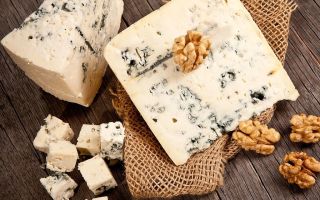Content
- 1 How is blue cheese made and can it be eaten
- 2 Types and names of blue cheeses
- 3 The chemical composition and calorie content of blue cheese
- 4 Is blue cheese good for you?
- 5 Can pregnant and lactating women eat moldy cheese?
- 6 Is it possible to give blue cheese to children
- 7 Useful properties of different types of blue cheese
- 8 How to eat blue cheese
- 9 Mold cheese for weight loss
- 10 What can be made from blue cheese
- 11 Homemade blue cheese recipe
- 12 Harm of blue cheese and contraindications
- 13 Selecting and storing blue cheese
- 14 Conclusion
- 15 Reviews
Gourmets from all over the world cannot deny themselves the desire to enjoy exotic products. Noble moldy cheese has become one of the most coveted dishes on festive tables. This article will describe in detail the origin of this delicacy, the rules for its use, and also consider the benefits and harms of blue cheese.
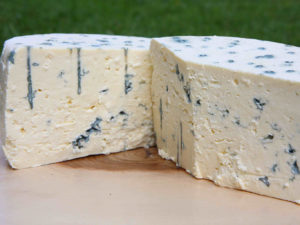
How is blue cheese made and can it be eaten
This type appeared on the shelves of domestic stores relatively recently, therefore it made a real sensation for inexperienced consumers. Myths and misconceptions still revolve around this product. The main consumer prejudice is stories about the dangers of blue cheese.
Obviously, mold on a piece of cheese lying in the refrigerator will signal that it should never be eaten. However, special varieties with blue, white and red mold have a special recipe for cooking, which originates from French cheese makers.
There are many ways of making such a product, as well as its varieties. It can be hard or soft. Some varieties are prepared from fatty (this is a prerequisite) cow's milk, for others - sheep and goat's milk is taken as a basis. Different cooking technologies differ depending on the color of the mold. But one thing remains unchanged - the product receives its multi-colored "blotches" due to special professional treatment with strains of harmless penicillin fungi.
Types and names of blue cheeses
As mentioned earlier, the cooking method and individual characteristics depend on each specific type of cheese. Their detailed description is in the following subsections.
With blue mold
Blue-mold cheeses are considered a noble variety of dairy products; they can be served on the table and used as an expensive delicacy. After cutting off a piece of such a product, numerous blue and green dots, as well as veins, can be found on the cut. Such an ornate pattern is provided by the cooking method:
- Milk is brought to the consistency of cottage cheese and poured into a special form.
- After all the serum is glass, the form is freed from excess liquid and rubbed with salt.
- Then comes the stage of introducing the strain of the fungus. This is done with a needle. The surface of the product is pierced several dozen times to allow the fungus to spread freely.
- Once the bulk of the work is done, the curd mass is placed in a well-ventilated area and allowed to mature.
The most famous varieties of this variety: Roquefort, Gorgonzola, Ble de Coss and Fourme d'Amber. The benefits and harms of blue cheese will be discussed later.
With white mold
White blue cheese is the most popular and common among gourmets and ordinary customers. The peculiarity of its manufacture is as follows:
- Similarly to the previous version, the milk is brought to a curdled state, placed in a mold and the excess liquid is poured.
- After that, the curd is carefully rubbed with salt.
- In this case, the fungal strains are not artificially introduced. The cheese “ripens” on its own, usually in basements where there is no access to light.
- The walls in such rooms are densely covered with noble fungi, which begin to actively develop in dairy products.
Popular white moldy cheeses are Brie and Camembert. The benefits and dangers of white cheese will be discussed later.
With red mold
The second name for this type is moldy cheeses with a washed crust. This is due to the principle of its preparation:
- Before the beginning of ripening, the curd mass is thoroughly washed several times with salted brine. This is necessary so that unnecessary "normal" fungal cultures do not develop in milk.
- After processing, strains of penicillin fungi are artificially introduced into the curd mass.
The type of red mold cheese is distinguished by the color of the crust - it can vary from bright orange to deep burgundy.
The chemical composition and calorie content of blue cheese
The indisputable benefits of mold cheeses are due to their chemical composition. They contain a large amount of vitamins and minerals necessary for the body. They are also an excellent natural source of protein. Protein is of organic origin, so it is easily absorbed by the stomach, quickly and completely digested, being processed into useful energy.
The chemical composition and caloric content of blue cheese depends on the specific type of fermented milk product. On average, 100 g of a delicacy accounts for about 350 kcal, however, these are general indicators - some varieties significantly exceed the calorie intake, while others, on the contrary, have a more modest energy value.
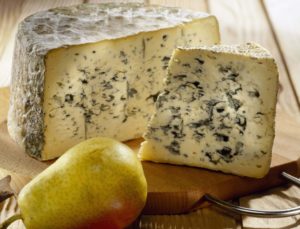
Is blue cheese good for you?
Cheeses with noble mold made from goat's milk are considered healthier. They are not as fatty, have less calories and are easily absorbed in the digestive tract. Also, goat milk itself is a natural source of phosphorus, vitamins A and B, iron and calcium.
Despite this, any species boasts a rich organic protein content. They quickly saturate the body, leaving you feeling full. Also, their composition boasts 9 essential amino acids necessary for the healthy functioning of the body, for example, histidine and validine. They are directly related to the process of cell regeneration and renewal. Moldy cheeses are often recommended for people who have undergone surgery or serious injury, as these amino acids contribute to quick healing and quick recovery of the skin.
Can pregnant and lactating women eat moldy cheese?
Despite its impressive benefits and a high content of useful trace elements, it is better not to eat cheese with mold for pregnant and lactating women. This delicacy is a rather specific product, and during periods when all the body's resources are directed to carrying or feeding a child, it can cause complex health disorders, from the heart, stomach and liver.
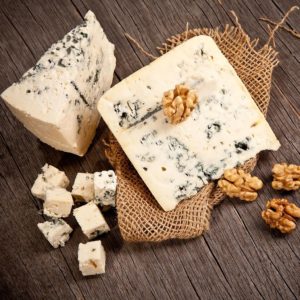
Is it possible to give blue cheese to children
Noble cheeses should be treated with due respect. They are quite expensive, and this is understandable - they do not need to be turned into an everyday product. The correct use of such a delicacy should be like tasting.
It is unusual not only in taste, but also in its biochemical properties.Therefore, it is contraindicated not only for pregnant and lactating mothers, but also for children under the age of adolescence.
Useful properties of different types of blue cheese
The benefits of moldy cheeses for the human body are undeniable. The varieties differ in their texture, appearance, and favorable properties. This is due to the difference in the content of various trace elements and vitamins, as well as differences in the composition.
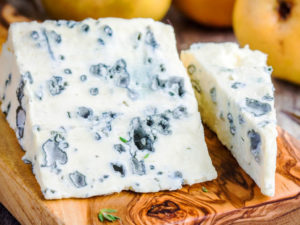
Roquefort
Roquefort is considered one of the most widely used blue cheese varieties. The benefits of this blue cheese are as follows:
- is an excellent and useful prophylaxis and therapy for diseases of the cardiovascular system;
- relieves inflammation, so it helps fight arthritis, gout and other diseases;
- slows down aging and also stimulates cell regeneration. Roquefort perfectly prevents wrinkles, and also stops the formation of subcutaneous fatty deposits - cellulite;
- Like all dairy products, this cheese is high in calcium. This has a beneficial effect on the condition of teeth, bones and nails;
- helps to replenish the balance of vitamins, minerals and beneficial amino acids with regular use.
Gorgonzola
In addition to its zesty taste, Gorgonzola has several beneficial properties that have important effects on well-being and health. It contains many proteins, easily digestible fats and vitamins necessary for normal life. In addition, Gorgonzola is considered to be a powerful organic antioxidant, and its mold actively promotes digestion.
Dor Blue
Dor Blue is an expensive cheese with noble mold, which has been recognized by thousands of connoisseurs of delicacies. It has a specific, but pleasant taste and aroma. The texture of Dor Blue is gentle and literally melts in your mouth. Like other types of cheese, it is high in protein, trace elements and vitamins. It is recommended for use by people involved in vigorous exercise, those with low immunity, or patients who have recently undergone trauma and surgery.
Stilton
The popular Stilton cheese is considered one of the main delicacies in England. His fame is supported by multiple facts. For example, world perfumers often use the spicy smell of Stilton cheese for their masterpieces. But the main secret of this product's popularity lies in its composition. Stilton contains a large amount of beneficial ascorbic acid, which strengthens the immune system, and choline, which stabilizes the amount of cholesterol in the blood.
You can learn more about the production and benefits of this blue cheese from the video:
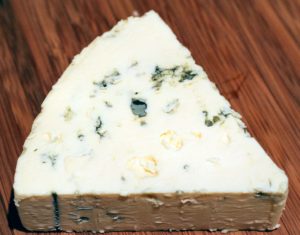
How to eat blue cheese
As mentioned earlier, moldy cheese is not an everyday product. Since this is an expensive delicacy, it should be tasted. The cheese is cut into thin and small pieces. There are 2 basic rules for the use of noble varieties of blue cheese:
- The product must not be eaten with hands. Pieces of cheese are taken from a cheese plate with a common device and transferred to personal dishes.
- Depending on the type of cheese, methods of serving are also distinguished. Some varieties need to be cut, while others, due to the peculiarity of their texture, are cut with a special blade.
When tasting cheese, it is incorrect to try to pick up the largest and most beautiful piece for yourself. The fact is that the core of the product and its crust differ significantly in taste, therefore, according to etiquette, it is necessary to let everyone at the table enjoy the delicacy.
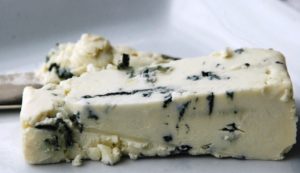
Mold cheese for weight loss
Blue cheese is not recommended for those who are scrupulous about their figure, or trying to lose extra pounds, because:
- contains a large proportion of sodium, the main property of which is fluid retention in the body;
- has a high percentage of fat (up to 42% on average);
- an impressive mass fraction of protein, because of which cheese will be difficult to fit into the daily balance of KBZhU (kcal of proteins, fats and carbohydrates).
Based on these nuances, it is better to refrain from eating moldy cheese while losing weight.
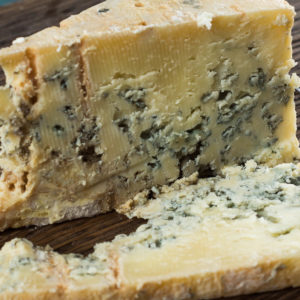
What can be made from blue cheese
The noble varieties of blue cheese can be viewed as a stand-alone product on a cheese plate, as well as ingredients in salads, soups, pies and sauces (for example, for spaghetti). It can also be served as a snack. For example, hot toast with moldy cheese can delight even the most sophisticated gourmets when combined with nuts, tomatoes, lettuce or even fruit.
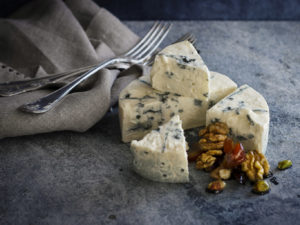
Homemade blue cheese recipe
It is not recommended to cook homemade blue cheese, as in non-professional conditions there is a high risk of developing unhealthy fungi that can harm the body. Moreover, it requires a lot of time and effort.
The following video describes in detail the process of making blue cheese at home:
Harm of blue cheese and contraindications
There are a number of contraindications, in the presence of which moldy cheese can cause serious harm to the body:
- Chronic diseases of the gastrointestinal tract, for example, pancreatitis, peptic ulcer, etc.
- Individual intolerance to individual components, especially allergy to penicillin.
- You should also carefully observe the dosage of the delicacy. With excessive enthusiasm for cheese, a reaction from the central nervous system can be observed: increased excitability, impressionability and insomnia.
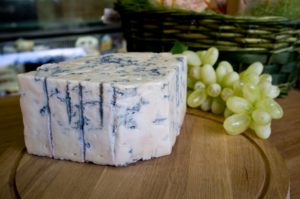
Selecting and storing blue cheese
As with any product, when choosing a cheese, the first thing to pay attention to is:
- date of manufacture of the delicacy;
- expiration date of blue cheese;
- storage conditions in closed and open containers.
The texture of quality cheese is soft and crumbly, however, under any conditions, it must remain intact and not fall apart in the hands.
They buy cheese in small portions due to the peculiarities of its storage. It is not recommended to leave the product in the refrigerator. After use, the cut should be covered with confectionery paper and try not to remove the delicacy from its factory shell.
Conclusion
Due to the low awareness of domestic buyers, the benefits and harms of mold cheese for many still remain a mystery. This is indeed a rather specific product, but with proper use, following the recommendations and contraindications, it will be an excellent addition to the dinner table and will not have a negative effect on the body. As sales grow, most of the preconceptions disappear, and fewer people believe that moldy cheese is bad.

